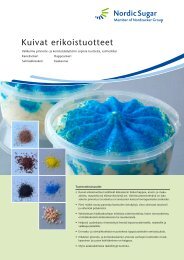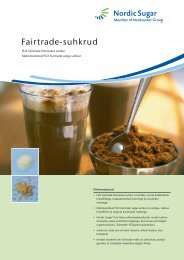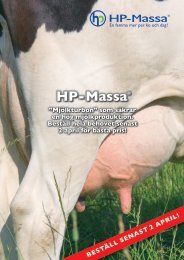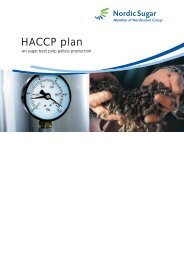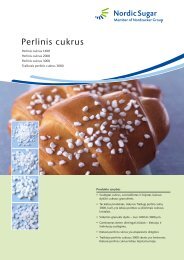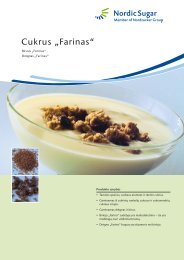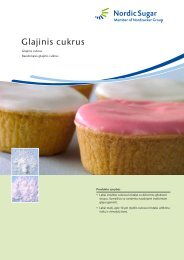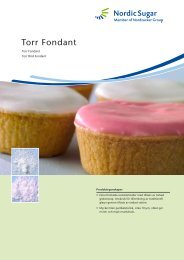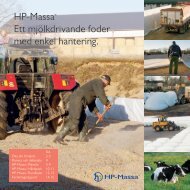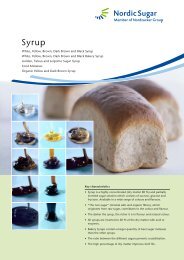HACCP plan
English - Nordic Sugar
English - Nordic Sugar
You also want an ePaper? Increase the reach of your titles
YUMPU automatically turns print PDFs into web optimized ePapers that Google loves.
<strong>HACCP</strong> <strong>plan</strong><br />
on HP-Pulp® production
Content<br />
1. Objectives<br />
1. Objectives<br />
2. The method<br />
3. Identification of<br />
CCPs and POAs<br />
4. Verification process<br />
5. Documentation<br />
The objectives with this booklet are to<br />
1. Explain and introduce Nordic<br />
Sugar’s <strong>HACCP</strong> work to customers<br />
and authorities<br />
2. Exchange general experiences with<br />
<strong>HACCP</strong> <strong>plan</strong>s throughout the<br />
organisation<br />
3. Create a common understanding<br />
of the <strong>HACCP</strong> method<br />
(calibration between factories)<br />
The current <strong>HACCP</strong> <strong>plan</strong> adresses<br />
product safety associated with<br />
production of HP-Pulp®.<br />
2. The method<br />
The <strong>HACCP</strong> <strong>plan</strong>s at Nordic Sugar are<br />
based on the GMP+ method (International<br />
Feed Ingredients Standard - IFIS)<br />
and the international food safety<br />
standard ISO 22000. We have taken<br />
every identified hazard in the whole<br />
process chain and evaluated them<br />
with regard to three basic steps in this<br />
method (the fourth step below is the<br />
verifi cation of the system). This<br />
procedure has clarified where the<br />
hazard should be controlled, how the<br />
hazard should be controlled and what<br />
verification procedures are necessary.<br />
1. Identification of chemical, physical,<br />
biological and allergenic hazards in<br />
each step of the process chain.<br />
2. In a risk assessment (2.2.) the<br />
severity and probability of each<br />
identified hazard are combined to<br />
determine the risk class and the type<br />
of control method necessary.<br />
3. By using the decision tree (2.3.) we<br />
have identified where the hazards<br />
should be controlled along the<br />
production chain. Based on the risk<br />
classes the decision tree is used to<br />
determine whether a given process<br />
step is a critical control point (CCP), a<br />
point of attention (POA/GMP) or just a<br />
periodic measure (PM).<br />
4. Apart from product specifications,<br />
process diagrams, risk analysis tables<br />
and summary tables, also activities<br />
towards verification of the <strong>HACCP</strong><br />
system are do cumented. These<br />
activities are e.g. audits, sampling and<br />
analysis of products, analysis of<br />
deviations and customer complaints.<br />
2.1. Severity<br />
and probability<br />
The severity of every possible hazard in<br />
the production chain has been<br />
estimated by the Nordic Sugar <strong>HACCP</strong><br />
Reference Group independent of the<br />
current production process. The<br />
probability of each hazard is very<br />
closely associated with the processes<br />
and the current process equipment.<br />
The probability has therefore been<br />
determined by the local <strong>HACCP</strong> group<br />
at the factory.<br />
- 2 -
2.2. Risk assessment matrix<br />
Severity<br />
Small Medium Great<br />
Great<br />
3<br />
POA<br />
Specific measures<br />
4<br />
CCP<br />
Critical measures<br />
4<br />
CCP<br />
Critical measures<br />
Probability*<br />
Medium<br />
2<br />
PM<br />
General measures<br />
3<br />
POA<br />
Specific measures<br />
4<br />
CCP<br />
Critical measures<br />
Small<br />
1<br />
No measures<br />
2<br />
PM<br />
General measures<br />
3<br />
POA<br />
Specific measures<br />
* Refers to the probability of the hazard being present in the end product e.g. at the moment of consumption.<br />
2.3. Decision tree<br />
Where will the hazard be controlled?<br />
Q1: Are there identified hazards present which have a harmful effect on the safety<br />
of the product and/or can the hazard exist or increase to unacceptable levels?<br />
Yes Q2, No stop!<br />
Q2: Which type of control measures are necessary according to the risk<br />
assessment?<br />
Critical measures (class 4) Q3, Specific measures (class 3) include<br />
measures as POA and in verification procedures,<br />
General measures (class 2) include measures as PM and in verification<br />
procedures or no measures (class 1) stop!<br />
Q3: Are the critical control measures referred to present?<br />
Yes Q4, No Modify the process or product and start again at Q1.<br />
Q4: Has this process step been specifically developed to eliminate the risk or<br />
reduce it to an acceptable level? No Q5, Yes CCP!<br />
Q5: Will the risk be eliminated in a subsequent process step or will it be reduced<br />
to an acceptable level? Yes Stop, No CCP!<br />
- 3 -
3. Identification of CCPs and POAs<br />
The way Nordic Sugar differs between a CCP and a POA<br />
CCP<br />
• A high risk step, which is likely to get out of control<br />
• Critical (and possible/applicable) control measures are needed in order to<br />
prevent, eliminate or reduce food & feed safety hazards to an acceptable level<br />
• If measures are out of control the corrective actions must include isolation of<br />
product batch, retesting, decontamination or destruction<br />
• The hazard is not eliminated or reduced to an acceptable level at a later stage<br />
in the process<br />
• If not in control the end product consitutes a serious health risk<br />
POA<br />
• A moderate risk step<br />
• Specific control measures essential to control the likelihood of introduction,<br />
contamination and/or proliferation of food & feed safety hazards<br />
• The hazard may be reduced at a later stage in the process<br />
• If measures are out of control the corrective actions include reevaluating<br />
procedure and/or checking equipment<br />
In total seven POAs and one CCP have<br />
been identified for the production of<br />
HP-Pulp® at an arbitrary Nordic Sugar<br />
factory (see 3.1. HP-Pulp® production<br />
process). Whether any of our factories<br />
have actually confirmed the existence<br />
of the CCP and POAs, is however<br />
dependent on the characteristics of<br />
the factory i.e. equipment, specific<br />
production parameters, intended use<br />
of the product etc.<br />
- 4 -
3.1 HP-Pulp production process<br />
General process steps and description of POAs<br />
Beet reception<br />
Stone catchers<br />
Beet wash<br />
+ process aids<br />
Slicing &<br />
extraction<br />
Biological = growth of pathogenic<br />
+ Molasses<br />
Mixing<br />
POA<br />
microorganisms if not right<br />
amount or quality of molasses is<br />
added when making silage<br />
Pulp stream<br />
POA<br />
Physical = hard and sharp metal<br />
objects<br />
Biological = not correct ensiling<br />
Storage<br />
POA<br />
if pulp is too old - risk of growth<br />
of pathogenic microorganisms<br />
Front loader<br />
Loading<br />
POA<br />
Physical = hard & sharp objects<br />
Transport<br />
To customer<br />
POA<br />
Biological = not correct ensiling<br />
if pulp is too old - risk of growth<br />
of pathogenic microorganisms<br />
POA<br />
Biological: contamination with<br />
processed animal protein<br />
See description of hazards,<br />
control measures, action limits<br />
and corrective actions for these<br />
process steps in table 3.2. and 3.3.<br />
- 5 -
3.2. Hazard analysis table (risk evaluation)<br />
Processing step<br />
Potential Hazards<br />
Control measures<br />
introduced, controlled or enhanced at this step<br />
applied at this step to prevent/reduce/<br />
eliminate the hazard.<br />
1 Beet reception<br />
(P) Introduction of objects (stones, cans & plastic)<br />
following the beets<br />
Information to the growers and transporters<br />
about inspection of beets before loading<br />
Waste bins at beet reception - signs!<br />
2 Mixing<br />
If dry matter (DM) incorrect and not enough molasses<br />
is added the ensilage process will not proceed properly<br />
to prevent growth of pathogenic microorganisms<br />
Addition of molasses with the right dry<br />
matter level<br />
3 Pulp stream<br />
(P) Removal of hard and sharp metal objects<br />
3 - 25 mm<br />
Magnet/metal detector<br />
4 Storage<br />
(B) If pulp is too old the ensilage proces will not be<br />
correct. Risk of growth of pathogenic microorganisms<br />
Visual inspection and cleaning of pulp storage area.<br />
Limitation of the maximum storage time. No leftovers<br />
should be present at the end of the day<br />
5 Loading<br />
Transport<br />
To customer<br />
(P) Contamination with hard and sharp objects<br />
3 - 25 mm<br />
(B) If pulp is too old the ensilage process will not be<br />
correct. Risk of growth of pathogenic mricroorganisms<br />
Visual inspection of storage area/trucks<br />
Dilivery to customers within 24 hours<br />
(B) Contamination with processed animal protein (BSE)<br />
Contract with transporters and random sampling of<br />
trucks<br />
*<br />
Refers to the questions in the Decision tree (see 2.3. Decision tree).<br />
B=Biological<br />
C=Chemical<br />
P=Physical<br />
SM=Specific measures<br />
PM=Perodic measures<br />
- 6 -
Evaluation of hazard<br />
Severity and probability in the<br />
Risk assessment matrix gives the<br />
risk class<br />
Is this step a critical control point?<br />
Decision tree questions<br />
CCP/POA/PM Comm. / Ref.<br />
1 / 2 / 3 / 4 / 5 *)<br />
Medium x medium = 3<br />
Yes / GM<br />
PM<br />
Beet reception and transport/grower<br />
agreement is a PM<br />
Great x small = 3<br />
Yes / SM<br />
POA<br />
Mixing is POA for microbiological hazards<br />
Medium x medium = 3<br />
Yes / SM<br />
POA<br />
Magnet/metal detectors are POA for<br />
metal hazards<br />
Great x small = 3<br />
Yes / SM<br />
POA<br />
Storage is a POA for microbiological<br />
hazards<br />
Medium x medium = 3<br />
Yes / SM<br />
POA<br />
Loading/transport to customers is a<br />
POA for physical Hazards<br />
Medium x medium = 3<br />
Yes / SM<br />
POA<br />
Loading/transport to customers is a<br />
POA for microbiological Hazards<br />
Great x small = 3<br />
Yes / SM<br />
POA<br />
Contract agreement and random samling of trucks<br />
is a POA for biological hazard (BSE)<br />
- 7 -
3.3 <strong>HACCP</strong> Summary table<br />
CCP<br />
Proces step<br />
Hazard<br />
Control<br />
Frequency<br />
or POA<br />
to control<br />
Method<br />
1 POA<br />
Mixing<br />
Too little molasses is added leading to<br />
insufficient ensilation<br />
Additition of right amount & DS of<br />
molasses secures proper ensilage<br />
proces<br />
Continuously<br />
2 POA<br />
Pulp stream<br />
Presence of hard & sharp objects<br />
Specific method to check the<br />
magnets or metal detectors<br />
Daily<br />
efficiency<br />
3 POA<br />
Storage<br />
Prolonged storage time of pulp resulting in<br />
growth of pathogenic microorganisms<br />
(mycotoxin producing moulds)<br />
Visual inspection & cleaning of<br />
pulp storing area - no leftovers<br />
at the end of the day<br />
(i.e. age of pulp)<br />
Daily<br />
4 POA<br />
Loading<br />
Transport<br />
Presence of hard & sharp objects<br />
3 - 25 mm<br />
Visual inspection when loading<br />
of vehicles<br />
At loading<br />
To customer<br />
Prolonged storage time of pulp resulting in<br />
growth of pathogenic microorganisms<br />
(mycotoxin producing moulds)<br />
Delivery to customer within<br />
24 hours - agreement with<br />
transporters<br />
Every delivery<br />
Processed animal protein (BSE) contaminating<br />
pulp during transport<br />
Contract with transporters about no<br />
transports of risk materials.<br />
Random verification of compliance<br />
Randomly at loading<br />
- 8 -
Action limit<br />
Corrective action<br />
- when action limit is exceeded<br />
Responsible<br />
Reference<br />
Target limit: 5% molasses, DM 73 - 77%<br />
Action limit: < 3,5% molasses & DM < 70%<br />
Evaluate risk of pulp since last check<br />
- discard if necessary<br />
Proces<br />
operator<br />
Local instructions for activities<br />
covering this area<br />
Target limit: Magnet should be working, checked<br />
daily. Automatic discard of pulp by metal detector<br />
Action limit: Magnets not working when checked.<br />
Evaluate risk of pulp since last check<br />
- discard if necessary<br />
Proces<br />
operator<br />
Local instructions for activities<br />
covering this area<br />
No discard when metal found in pulp stream<br />
Target limit: Storage time < 24 hours<br />
Action limit: Storage time > 24 hours<br />
Discard old pulp<br />
Head of<br />
storage<br />
Local instructions for activities<br />
covering this area<br />
Target limit: Visually clean vehicles<br />
Action limit: Visually unclean vehicles<br />
Vehicles are returned for cleaning<br />
Storeman<br />
Local instructions for activities<br />
covering this area<br />
Target limit: Delivery within 24 hours from<br />
production<br />
Action limit: Delivery later than 24 hours from<br />
Discard old pulp<br />
Truck<br />
driver<br />
Local instructions for activities<br />
covering this area<br />
production<br />
Target limit: Confirmation that no-risk materials<br />
has been transported<br />
Action limit: Transport of risk materials<br />
Vehicle is rejected<br />
Operator at<br />
weighing bridge<br />
Local instructions for activities<br />
covering this area<br />
- 9 -
4. Verification process<br />
Sustaining a high quality and secure<br />
<strong>HACCP</strong> system requires continuous<br />
evaluation and review of the system.<br />
A Nordic Sugar review of the risk<br />
analysis and verification of the <strong>HACCP</strong><br />
<strong>plan</strong>s consists of the following<br />
elements:<br />
• Trend analyses of monitoring of<br />
POAs and or CCPs e.g. how often<br />
do we identify broken sieves<br />
• Sampling and analysis of end<br />
products as a part of our<br />
quality program.<br />
• Evaluation of complaints and/or<br />
emergencies reported to<br />
Nordic Sugar.<br />
• Internal and external audits.<br />
Audits -with focus on e.g. hygiene and<br />
<strong>HACCP</strong> are performed by internal and<br />
external parties.<br />
These elements are used to verify the<br />
current <strong>HACCP</strong> <strong>plan</strong>s at the different<br />
production sites. The verification is<br />
done whenever necessary and at least<br />
once a year.<br />
- 10 -
5. Documentation<br />
In the description of our <strong>HACCP</strong><br />
system the following documents are<br />
included:<br />
• <strong>HACCP</strong> team documents<br />
(members and areas of expertise)<br />
• Flowcharts i.e. process diagrams<br />
• Hazard analysis tables<br />
• <strong>HACCP</strong> summary tables<br />
(comprising exclusively POAs<br />
and CCPs)<br />
These documents are handled in the<br />
document management system (DMS)<br />
for each factory. The product safety<br />
manager located at the production site<br />
supports the management and<br />
updates the documentation.<br />
Deviations from criteria set for CCPs/<br />
POAs are reported and registered in a<br />
Deviation Database and/or the<br />
Laboratory Information Management<br />
System (LIMS) or Production Information<br />
Management System (PIMS).<br />
Deviations identified at the factories<br />
(at e.g. audits) are reported and<br />
communicated in a Deviation<br />
Database. Customer complaints are<br />
registered in a similar database,<br />
”Sugar Complaints for sugar,<br />
Fibrex and animal feed products”.<br />
- 11 -
Printcentret langebrogade 1 v. 08 - OKT 2009<br />
Nordic Sugar A/S | Langebrogade 1 | PO Box 2100 | 1014 Copenhagen K | Denmark | +45 3266 25 00<br />
www.nordicsugar.com



